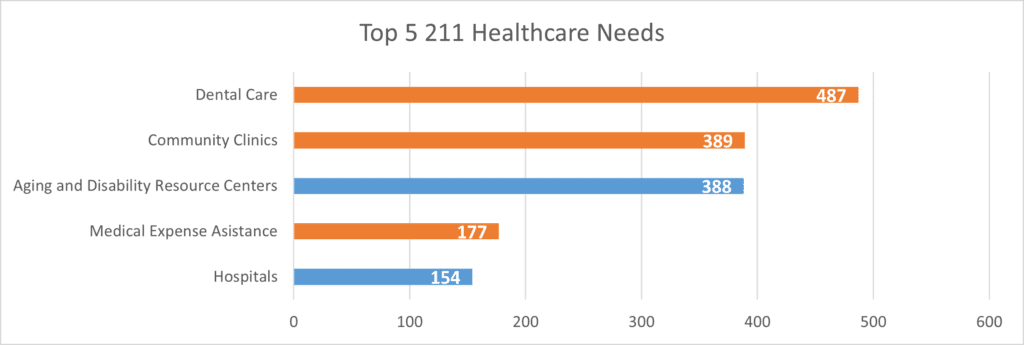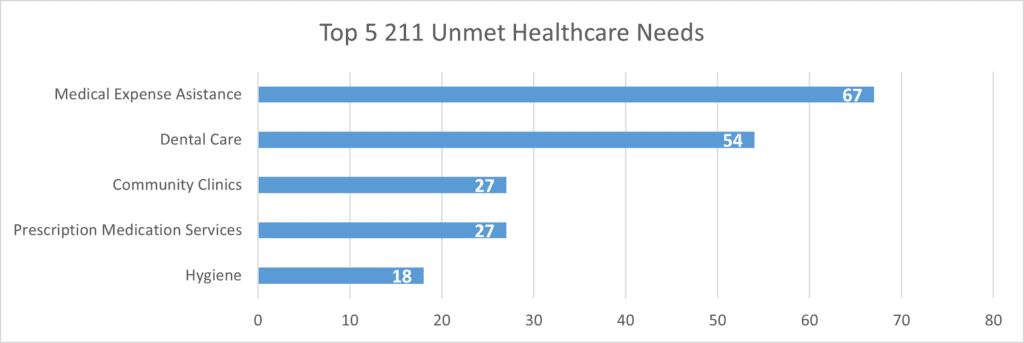Understanding Local Health Needs
-
Individuals across the metro find it difficult to access care
-
Staff shortages play a significant role, and appear to be getting worse across the state
-
Healthcare needs to 211 mirror unmet needs
-
Community Health Workers are helping to address health disparities and health literacy through culturally appropriate outreach to target populations
An extensive review of 26 Nebraska and metro area-based reports revealed healthcare as an issue with significant community focus. Two themes across these reports include:
- Poor access to affordable basic health services and staffing shortages are creating barriers to care across the state.
- Healthcare outcome, access and support varies greatly, particularly for lower income and BIPOC populations.
The reports and surveys conducted by our local health departments, Nebraska Medicine, non-profits and many more find it’s simply harder to get seen for care – and staff shortages are contributing to the problem.
The 2021 Community Health Needs Assessment found just over 50% of people had difficulty seeking primary care in the past year. The most reported issue was not being able to make an appointment, followed by cost barriers and transportation. The report also found the lower the income, the higher likelihood of having delayed care in the past year. A 2020 report with the Omaha Community Foundation found affordable and accessible health services was a major point of discussion with residents. Specifically, they hoped for improved resources for basic care, mental health care and addiction services.
While COVID played a large role in delays, staffing troubles have persisted. A 2019 report with Voices for Children in Nebraska examined shortages in relation to geography, population sub-groups and facilities. For every county they estimated a shortage of 100 primary care providers and 164 mental health providers. These numbers increased even further in their 2022 report to 126 primary care providers and 172 mental health providers. According to a 2020 report on our healthcare workforce, we are not only losing physicians and specialists in the workforce, but part of the issue is they are moving out of our rural areas, leaving those populations with even fewer sources of care.
The list of 211 healthcare needs mirrors unmet healthcare needs.
When people call 211 with healthcare needs, people call most often with needs for community clinics, aging and disability services, and dental care. These three needs have consistently topped the list over the last two years. The 4th and 5th most common calls are for medical expense assistance and hospitals. What might be most surprising is the high demand for dental care assistance among 211 callers. The 2021 Community Needs Assessment finds oral health in decline across the state, which is further complicated by a shrinking pool of medical dental care providers. For most people, costs are the barrier to care, which only balloons further as issues are not cared for. According to DHHS, nearly 60% of Nebraska’s children deal with tooth decay before they even reach Kindergarten. And, although dental care is treated as an entirely separate, elective form of care it is highly correlated to other serious health issues such as diabetes, Alzheimer’s and mental illness.
211 Healthcare Needs and Unmet Needs Are Nearly Identical
Breakdown of 211 Helpline Health Calls By Need Subcategory Compared with A Breakdown of Unmet Health Needs by Subcategory


When 211 specialists cannot provide a referral for a caller request, they log an unmet need. The most common reason a need may be unmet is because no program exists. This is most common among medical expense assistance. Here it is important to note that while nearly 70% of unmet health needs were related to medical expenses assistance, overall, 211 is able to provide roughly 80% of health callers with a resource.

Frequency of Unmet Needs Due to No Program Available for Health Calls by Subcategory

Across the U.S., communities face imbalances in access, quality and outcomes in their healthcare systems -- Nebraska is no exception.
In Omaha, BIPOC communities experience higher rates of health issues and a higher likelihood of destabilizing factors that exacerbate health risks. While the disparities in our communities are unfortunately not unique, the details hold the keys to repairing balance and healthcare equity in the Omaha-Council Bluffs metro and across the state.
- Survey findings show disparities in mental health and general health disparities across groups by income, age, sex, race and location.
- Mental health struggles were highest for groups including youth, low-income earners, women, and Black and Hispanic communities.
- General health as “poor” or “fair” was highest for groups including seniors, low-income earners, and Black and Hispanic communities.
- Infant mortality rates found to be dramatically worse for Indigenous, Black and Hispanic populations.
The 2021 Community Needs Assessment reveals that some of the largest health disparities occur geographically, particularly areas populated by lower-income, Black and Hispanic communities.
BIPOC and low-income families also report higher rates of feeling treated as less intelligent, less respected and more unfairly treated in day-to-day life. Similarly, these demographic populations report the highest rates of low-health literacy. Ideas of things like good health, hygiene and preventative care are often cultural. Area providers are seeking to build increased trust is by employing Community Health Workers to meet and consult with patients. People with a similar background and personal experience with the health matters can help a patient navigate to appropriate supports.
UWM’s strategic investment in community health workers has proven instrumental in bridging gaps to access, fostering a healthier community today, and laying the foundation for a stronger tomorrow. By funding these dedicated professionals in trusted nonprofits across the metro, we have not only enhanced healthcare accessibility but also addressed systemic barriers that disproportionately affect vulnerable populations. As we move forward, UWM remains committed to building on this foundation, continuously striving for equitable healthcare and envisioning a community where well-being knows no bounds.
Sources:
Professional Research Consultants: Community Health Needs Assessment. 2021.
Omaha Community Foundation: Landscape Listening Report. 2020.
Voices for Children: Nebraska Kids Count, 2019.
University of Nebraska Medical Center: Status of the Nebraska Healthcare Workforce. 2020.